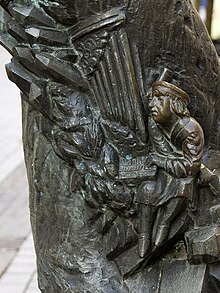Gottfried Silbermann

Gottfried Silbermann (January 14, 1683 – August 4, 1753) was a German builder of keyboard instruments.[1] He built harpsichords, clavichords, organs, and fortepianos; his modern reputation rests mainly on the latter two.
Life
Very little is known about Silbermann's youth. He was born in Kleinbobritzsch (now a part of
Silbermann's organs

The organs that Silbermann and his brother Andreas Silbermann built show a clear and distinctive style, both in architecture and in their music qualities. Gottfried Silbermann never deviated from this style. His ability to earn money with organ construction was remarkable, leading him to uncommon wealth, and his economic operation and slow consolidation of his position eventually created a near monopoly. His apprentices had to pledge never to work in Central Germany.
Silbermann's non-negotiable style was not welcome everywhere, an important example of an opponent being Johann Sebastian Bach, who, unlike Silbermann who tuned in meantone temperament, preferred a more flexible tuning.
Silbermann designed and built approximately 50 organs, 35 of which are identified as extant by the Gottfried Silbermann Society, including the organ in the
Silbermann and the piano
Silbermann was also a central figure in the history of the
Evidence from the
In his mature pianos, Silbermann scrupulously copied the complex action found in Cristofori's last instruments, failing only to produce a correct copy of the back check. Silbermann also copied another ingenious Cristofori invention, the inverted wrest plank. In other respects (case construction, choice of wood species, string diameters and spacing, keyboard design), Silbermann relied on his own experience as a harpsichord builder.
During the 1740s, King
There is a Silbermann original in the Germanisches Nationalmuseum. The famous Carl Philipp Emanuel Bach was employed by Frederick the Great in Potsdam and was playing Silbermann fortepianos (also accompanying Frederick on the traverso flute),[6] so in this way Silbermann pianos are connected with the CPE Bach name and his music, which was written for this particular fortepiano model.
Two of Silbermann's pianos are still located in Frederick's palaces in Potsdam today.[7] There is also an original Silbermann piano in the Germanisches Nationalmuseum. Gottfried Silbermann's 1749 instrument has been used as a model for making modern piano copies.[8]
The forerunner of the damper pedal
Silbermann invented a device by which the player could lift all of the dampers off the strings, permitting them to vibrate freely, either when struck or
There are at least two possible reasons for why Silbermann invented his damper-lifting mechanism. First, as an organ builder, he may have favored the idea of providing the player with a variety of tonal colors. The same impulse led German harpsichord builders of the time to occasionally include two-foot (two octaves higher than normal pitch) and sixteen-foot (one octave lower) choirs of strings in their instruments.
In addition, Silbermann had until 1727 built very large
Silbermann and Bach
The 18th-century musician
Silbermann's pupils
Silbermann's most important contribution to the piano may have been as the teacher of other builders. His nephew and pupil Johann Andreas Silbermann was the teacher of Johann Andreas Stein, who perfected the so-called "Viennese action", found in the pianos used by Haydn, Mozart, and Beethoven. Another group of Silbermann pupils were the so-called "twelve apostles". These builders fled Germany during and after the time of chaos created by the Seven Years' War (1756–1763), migrating to England, where economic prosperity was creating new opportunities for instrument builders. The "twelve apostles" included Johannes Zumpe, whose invention of an affordable small square piano greatly popularized the instrument. They also included Americus Backers, one of the inventors of the "English action", which was a modified version of the Cristofori action.
Silbermann's role was crucial because, unlike other builders of his day, he refused to compromise on the quality of the action. Cristofori's action was complex and hard to build, leading many builders (e.g. Zumpe) to use instead a simplified, but clumsier action. Through Backers and others, the original conception of a complex but effective action survived. The English action was later modified and improved further by Sébastien Érard and Henri Herz to yield the action used in all grand pianos today. With the advent of industrial methods of manufacture, it ultimately became economical to include the complex modern action even in inexpensive pianos, thus vindicating Silbermann's original decision.
Silbermann's fame as a builder and teacher was such that for many decades he was regarded as the inventor of the piano; it was only with nineteenth-century scholarship that this honor was restored to Cristofori.
See also
Notes
- ^ ISBN 978-1-56159-263-0. Retrieved 2021-06-19.
- ^ Kümmerle, Salomon (1894). Encyklopädie der evangelischen Kirchenmusik, Band 3. C. Bertelsmann Verlag. p. 394. Retrieved 20 August 2010.
- ^ "Orgellandschaft".
- ^ Marx, Wolfgang. Notes on the Organs in Volume 8 of the Bach 2000 edition.
- ^ "Silberkünstler - Silber-Läuterung - Silber liefern - Silberling - Silber-Löffel - Silbermagisterium - Silbermagisterium, Uladislai - Silber Mann oder Silberner Mann - Silbermann, Gottfried - Blättern im Zedler-Lexikon Bd. 37, Seite 645". www.zedler-lexikon.de. Retrieved 2021-06-19.
- ISBN 978-1-4724-4337-3.
- ^ "Hammerflügel :: Stiftung Preußische Schlösser und Gärten Berlin-Brandenburg :: museum-digital:brandenburg". brandenburg.museum-digital.de. Retrieved 2021-06-19.
- ^ "Malcolm Bilson: The Pattern-Prelude Tradition of J. S. Bach and the Silbermann Piano as Precursors to Beethoven's Moonlight – Cornell Center for Historical Keyboards". Retrieved 2021-06-24.
- ISBN 0-393-32256-4. p. 413
References
- The organ portion of this article is based on a translation from the German Wikipedia. The original is located here.
- For the piano portion, the following two reference works were relied on:
- Good, Edwin M. (1982). Giraffes, Black Dragons, and other Pianos: A Technological History from Cristofori to the Modern Concert Grand. Stanford, California: Stanford University Press.
- Pollens, Stewart (1995). The Early Pianoforte. Cambridge: Cambridge University Press.
External links
- www.silbermann.org Gottfried-Silbermann-Society
- (in German) Life of Silbermann
- Potsdam
- Germanische National Museum in Nuremberg
- (in German) www.silbermannorgel-crostau.de Silbermann organ at Crostau
